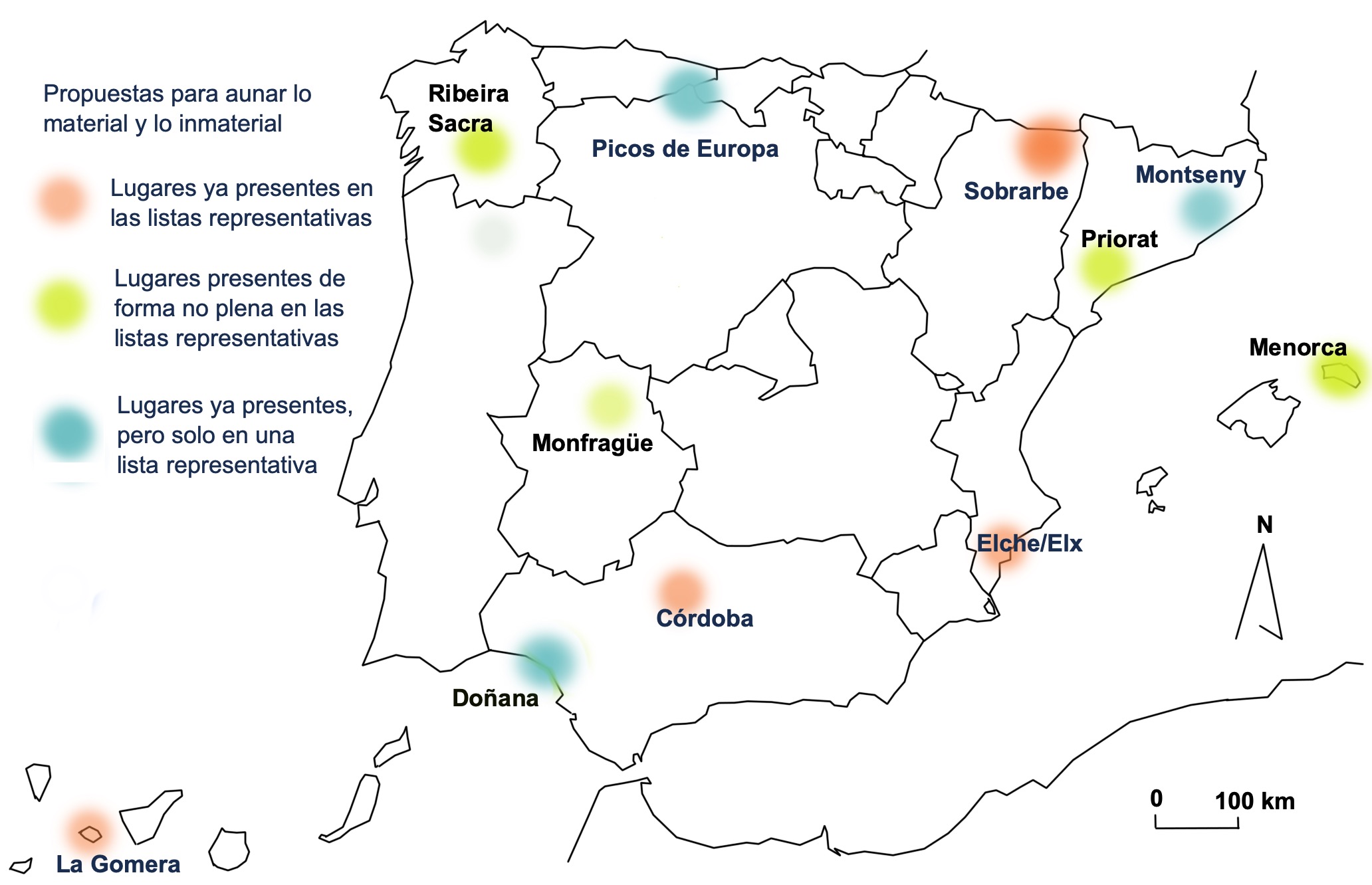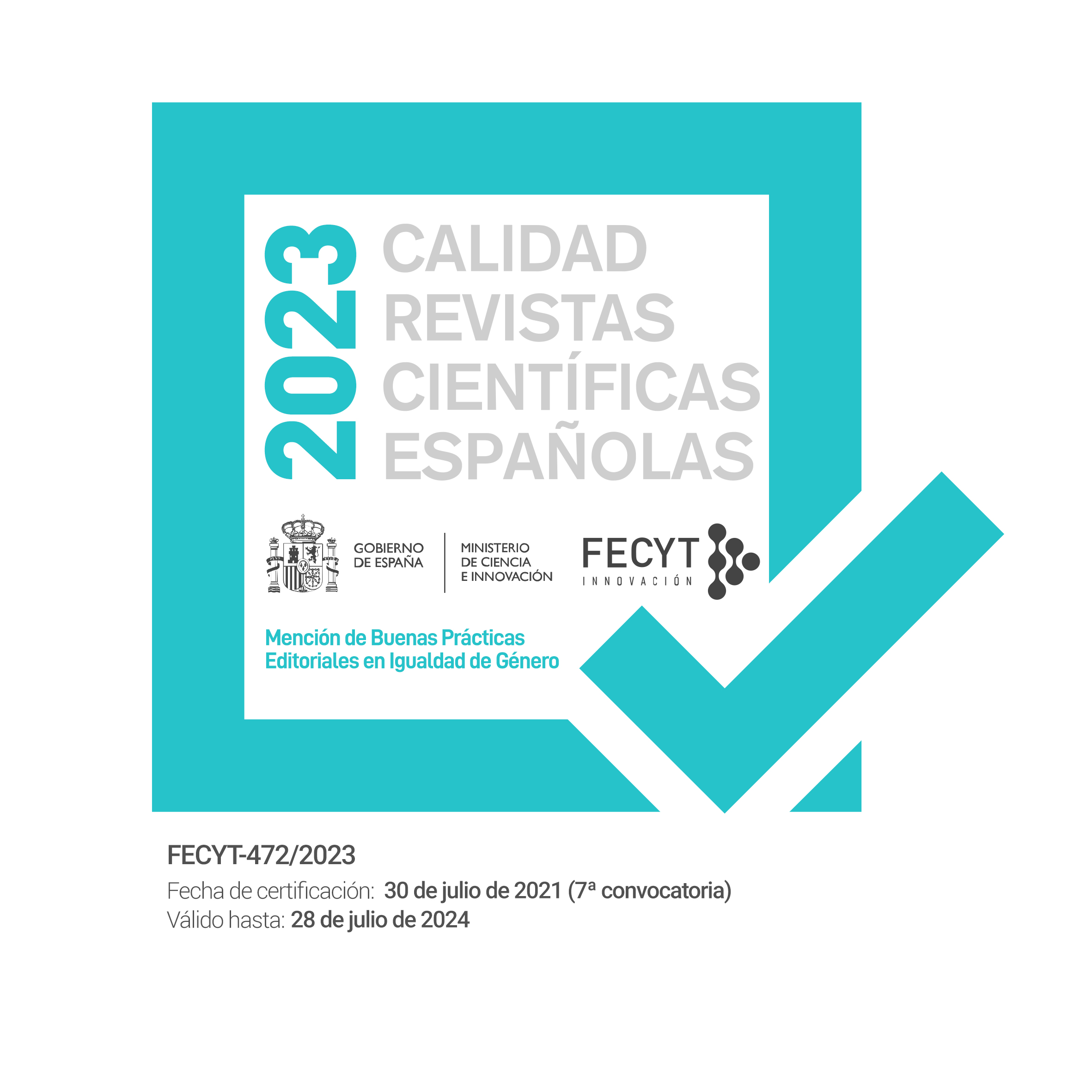Hacia un reconocimiento territorial conjunto de las listas representativas patrimoniales de la Unesco.
Propuesta de casos españoles que aúnen valores materiales e inmateriales.
DOI:
https://doi.org/10.30827/erph.32.2023.28830Palabras clave:
Unesco, Patrimonio Mundial, Patrimonio Cultural Inmaterial, Valores patrimoniales, Territorios patrimonialesResumen
Durante los últimos decenios, se está produciendo un acercamiento, a menudo confuso, entre el patrimonio material y el inmaterial. El desplazamiento del eje gravitacional del objeto al sujeto y, en consecuencia, la consideración del patrimonio como el valor que se le asigna a ciertos elementos, bien de forma institucional, bien de forma identitaria, está haciendo recalcular el significado y misión de los reconocimientos patrimoniales internacionales más prestigiosos. Este artículo parte de la premisa de que, en la asignación de ese valor patrimonial, la materialidad puede ser más o menos importante (grande en el patrimonio inmueble, mínima o nula en el inmaterial), pero la espacialidad, en cambio, siempre es un componente básico. Valor y espacio son pues dos referentes clave que precisan de un entendimiento simultáneo, correlacionado y que supere las taxonomías patrimoniales clásicas. Así, se reflexiona sobre los grandes programas internacionales de reconocimiento patrimonial representativo (la Lista del Patrimonio Mundial y los listados Patrimonio Cultural Inmaterial) y sobre las estrategias que deben orientar, a partir del nuevo marco conceptual, la tutela y la activación del patrimonio. Como conclusión principal, y tras proponer un listado español de bienes susceptibles de una lectura conjunta en las listas patrimoniales representativas de la Unesco, se apunta a la necesidad de establecer programas y listados de bienes convergentes, permeables a las políticas de desarrollo territorial y más atentos, no solo a los aspectos ambientales, sin duda imprescindibles, sino también a las bases sociales que sustentan la autenticidad del patrimonio.
Descargas
Citas
ALCAIDE, R. (2020). “Córdoba, la única ciudad del mundo con cuatro bienes nombrados Patrimonio de la Humanidad”, La Razón, 26 de junio de 2020. En línea en: <https://www.larazon.es/viajes/20200624/joijfi2yz5cf7bqi4cywu4we3a.html> [Consulta: 12.07.2023].
ALICANTEOUT. GUÍA DE OCIO Y CULTURA DE ALICANTE (s. f.). “Elche, Patrimonio de la Humanidad”, Alicante: AlicanteOut. En línea:
<https://alicanteout.com/que-ver-en-alicante/elche-patrimonio-humanidad/#:~:text=La%20ciudad%20cuenta%20con%20tres,y%20el%20Museo%20de%20Pusol.l> [Consulta: 14.07.2023].
BORTOLOTTO, C. (2007). “From Objects to Processes: UNESCO'S Intangible Cultural Heritage”. Journal of Museum Ethnography, (19), pp. 21-33. En línea: <https://www.jstor.org/stable/40793837> [Consulta: 18.07.2023] .
CALDERÓN CALDERÓN, B. y GARCÍA CUESTA, J. L. (2016). “Patrimonio y territorio en España: fundamentos y estrategias para la gestión de la cultura territorial”. En: Fernando Manero Miguel y José Luis García Cuesta eds. Patrimonio Cultural y Desarrollo Territorial, Cizur Menor (Navarra): Thomson Reuters Aranzadi, pp. 51-105.
CAMPOS, J. M. (2021). “Los alcaldes piden que Picos sea Patrimonio de la Humanidad. Oseja de Valdeón reclaman más inversiones y menos restricciones”. Diario de León, 17 de noviembre de 2021. En línea: <https://www.diariodeleon.es/articulo/provincia/alcaldes-piden-que-picos-sea-patrimonio-humanidad/202111170333422164052.html> [Consulta: 13.07.2023].
CANTÓN, V. (2015). “La educación patrimonial: entre el objeto y el sujeto: una apuesta transdisciplinaria”. En: Cristina Amescua Chávez e Hilario Topete Lara eds., Experiencias de salvaguardia del patrimonio cultural inmaterial, Ciudad de México: Bonilla Artigas, pp. 439-465.
CASTILLO RUIZ, J. (2022). Los límites del patrimonio cultural: Principios para transitar por el desorden patrimonial. Madrid: Cátedra.
COMISSIÓ DEL PAISATGE I LA SOSTENIBILITAT DE PRIORAT-MONTSANT-SIURANA (s. f.). Candidatura Priorat-Montsant-Siurana, paisatge cultural agrícola de muntanya mediterrània. En línea: <http://www.candidaturapriorat.org> [Consulta: 14.07.2023].
FERIA TORIBIO, J. M. (2013). “El patrimonio territorial: algunas aportaciones para su entendimiento y puesta en valor”. E-rph: Revista Electrónica de Patrimonio Histórico, en línea, 12, pp. 200-224. En línea: https://digibug.ugr.es/bitstream/handle/10481/35999/patrimonio-estudios.pdf?sequence=1&isAllowed=y [Consulta: 14.07.2023].
JIMÉNEZ ESQUINAS, G. (2017). “El patrimonio (también) es nuestro. Hacia una crítica patrimonial feminista”. En: Iñaki Arrieta Urtixberea ed., El género en el patrimonio cultural. Bilbao: Universidad del País Vasco, pp. 19-48. En línea: <https://addi.ehu.es/bitstream/handle/10810/26047/arrieta_2017_genero.pdf?sequence=1&isAllowed=y> [Consulta: 14.07.2023].
KIM, H.-E. (2011). “Changing climate, changing culture: adding the climate change dimension to the protection of intangible cultural heritage”. International Journal of Cultural Property, 18(3), pp. 259-290. En línea: <https://www.cambridge.org/core/journals/international-journal-of-cultural-property/article/abs/changing-climate-changing-culture-adding-the-climate-change-dimension-to-the-protection-of-intangible-cultural-heritage/AE113BC2E4BC871EB8EE8A8FDE35CF9E> [Consulta: 21.07.2023]. DOI: https://doi.org/10.1017/S094073911100021X
LAFUENTE BATANERO, L. (2009). “La Lista indicative Española”. Revista del Patrimonio Mundial, 53, pp. 124-131. En línea: <https://unesdoc.unesco.org/ark:/48223/pf0000183756_spa> [Consulta: 23.06.2023].
MARCOS ARÉVALO, J. (2004). “La tradición, el patrimonio y la identidad”. Revista de estudios extremeños, 60(3), pp. 925-956. En línea: <https://gc.scalahed.com/recursos/files/r161r/w24359w/S3_R2.pdf> [Consulta: 22.06.2023].
MARRIE, H. (2009). “The UNESCO Convention for the Safeguarding of the Intangible Cultural Heritage and the protection and maintenance of the intangible cultural heritage of indigenous peoples”. En Laurajane Smith y Natsuko Akagawa eds., Intangible heritage. Abindong (Reino Unido): Routledge, pp. 183-206. En línea: <https://books.google.es/books?hl=es&lr=&id=5T99AgAAQBAJ&oi=fnd&pg=PA169&dq=intangible+heritage+indigenous&ots=7UdHhpZXQ7&sig=NhwrUtV9rpd2jf5iLoMDzqlZ1KE#v=onepage&q=intangible%20heritage%20indigenous&f=false> [Consulta: 23.06.2023].
MARTÍNEZ YÁÑEZ, C. (2010). “La redefinición del valor universal excepcional y el futuro de la Lista del Patrimonio Mundial”. E-rph: Revista Electrónica de Patrimonio Histórico, en línea, 6, pp. 1-22. En línea: <http://www.revistadepatrimonio.es/revistas/numero6/concepto/estudios/articulo.ph> [Consulta: 13.07.2023].
MASSEY, D. (2004). “Lugar, identidad y geografías de la responsabilidad en un mundo en proceso de globalización”. Treballs de la Societat Catalana de Geografia, (57), pp. 77-84. En línea: <https://www.raco.cat/index.php/TreballsSCGeografia/article/view/247695> [Consulta: 29.06.2023].
MESKELL, L. y BRUMANN, C. (2015). “UNESCO and new world orders”. En: Lynn Meskell ed., Global Heritage: A Reader. Chichester (Reino Unido): Wiley Blackwell, pp. 22-42. En línea: <https://books.google.es/books?hl=es&lr=&id=0qMKCAAAQBAJ&oi=fnd&pg=PA22&dq=unesco&ots=k77oCWmMhp&sig=0Bequp5At5gvHIGFUuDRzncT1QA#v=onepage&q=unesco&f=false> [Consulta: 12.07.2023].
MIGUEL RIERA, L. de (2022). “La Lista del Patrimonio Mundial: el riesgo de morir de éxito”. Revista PH Instituto Andaluz del Patrimonio Histórico, (107), pp. 64-83. En línea: <https://www.iaph.es/revistaph/index.php/revistaph/article/view/5148> . DOI: https://doi.org/10.33349/2022.107.5148
OLWIG, K. R. (2006). “Introduction: The Nature of Cultural Heritage, and the Culture of Natural Heritage—Northern Perspectives on a Contested Patrimony”. En; David Lowenthal y Kenneth R. Olwig, eds., The nature of cultural heritage, and the culture of natural heritage. Abindong (Reino Unido): Routledge, pp. 1-5. DOI: https://doi.org/10.1080/13527250500036742
PRATS, L. (2000). “El concepto de patrimonio cultural”. Cuadernos de antropología social, (11), pp. 115-136. En línea: https://dialnet.unirioja.es/servlet/articulo?codigo=7174790 [Consulta: 29.06.2023].
SANTACANA MESTRE, J. y PRATS, J. (2014). “El patrimonio inmaterial y la educación: bases conceptuales para un planteamiento didáctico”. Her&Mus. Heritage & Museography, 15, pp. 8-15. En línea: <https://www.raco.cat/index.php/Hermus/article/view/313274> [Consulta: 11.07.2023].
SCHAAF, T. Y RODRIGUES, D. C. (2016). Managing MIDAs: Harmonising the Management of Multi-internationnaly Designated Areas: Ramsar Sites, World Heritage Sites, Biosphere Reserves and UNESCO Global Geoparks. Gland (Suiza): IUCN International Union for Conservation of Nature and Natural Resources. Disponible en: <https://www.researchgate.net/profile/Diana-Rodrigues-21/publication/312024778_Managing_MIDAS_-_Harmonising_the_management_of_Multi-Internationally_Designated_Areas_Ramsar_Sites_World_Heritage_sites_Biosphere_Reserves_and_UNESCO_Global_Geoparks/links/586a3bb608ae329d621015f1/Managing-MIDAS-Harmonising-the-management-of-Multi-Internationally-Designated-Areas-Ramsar-Sites-World-Heritage-sites-Biosphere-Reserves-and-UNESCO-Global-Geoparks.pdf> [Consulta: 4 de julio de 2023]. DOI: https://doi.org/10.2305/IUCN.CH.2016.03.en
SILVA PÉREZ, R. y FERNÁNDEZ SALINAS, V. (2017). “El nuevo paradigma del patrimonio y su consideración con los paisajes: Conceptos, métodos y prospectivas”. Documents d’Anàlisi Geogràfica, 63(1), pp. 129-151. En línea: <https://doi.org/10.5565/rev/dag.344> [Consulta: 12.06.2023]. DOI: https://doi.org/10.5565/rev/dag.344
SILVA PÉREZ, R. y FERNÁNDEZ SALINAS, V. (2020). “La consideración (y desconsideración) del territorio en los programas patrimoniales territoriales de la Unesco: Convención del Patrimonio Mundial, Programa Hombre y Biosfera (MaB) y Programa Internacional de Ciencias de la Tierra y Geoparques”. Boletín de la Asociación de Geógrafos Españoles, (86). En línea: <https://doi.org/10.21138/bage.2987> [Consulta: 23.06.2023]. DOI: https://doi.org/10.21138/bage.2987
UNESCO (s. f.). “Salvaguardar nuestro patrimonio vivo”. Unesco. Patrimonio Cultural Inmaterial. En línea: <https://www.unesco.org/en/iggp/geoparks/about> [Consulta 18 de julio de 2023].
SILVA PÉREZ, R. y FERNÁNDEZ SALINAS, V. (1972). Convención para la Protección del Patrimonio Mundial Cultural y Natural. París: Centro del Patrimonio Mundial. En línea: <https://whc.unesco.org/archive/convention-es.pdf> [Consulta: 12.05.2023].
SILVA PÉREZ, R. y FERNÁNDEZ SALINAS, V. (2003). Convención para la Salvaguardia del Patrimonio Cultural Inmaterial. París: Unesco-Patrimonio Cultural Inmaterial. En línea: <https://ich.unesco.org/es/convención> [Consulta: 12.05.2023].
SILVA PÉREZ, R. y FERNÁNDEZ SALINAS, V. (2021) Operational Guidelines for the Implementation of the World Heritage Convention. París: Unesco. En línea: https://whc.unesco.org/en/guidelines/> [Consulta: 21.06.2023].
SILVA PÉREZ, R. y FERNÁNDEZ SALINAS, V. (2022). Textos Fundamentales de la Convención para la Salvaguardia del Patrimonio Cultural Inmaterial de 2003. París (Francia): Unesco. En línea: <https://ich.unesco.org/doc/src/2003_Convention_Basic_Texts-_2020_version-SP.pdf> [Consulta: 3 de julio de 2023].
UNESCO y GEOPARQUES MUNDIALES DE LA UNESCO (2017). Los geoparques mundiales de la Unesco: celebrando el patrimonio de la tierra, sosteniendo las comunidades locales. París (Francia): Unesco. En línea: <https://unesdoc.unesco.org/ark:/48223/pf0000243650_spa> [Consulta: 01.07.2023].
WORLD HERITAGE CENTER (CENTRO DEL PATRIMONIO MUNDIAL) (s. f.). “World Heritage List”. Unesco World Heritage Convention. París (Francia): Centro del Patrimonio Mundial. En línea: <https://whc.unesco.org/en/tentativelists/5854/> [Consulta: 19.07.2023].
SILVA PÉREZ, R. y FERNÁNDEZ SALINAS, V. (2014). “Priorat-Montsant-Siurana paysage agricole de la montagne méditerranéenne” [Tentative list], Unesco. World Heritage Convention. París: Centro del Patrimonio Mundial. En línea: <https://whc.unesco.org/en/tentativelists/5854/> [Consulta: 19.07.2023].

Descargas
Publicado
Versiones
- 2024-07-02 (3)
- 2023-10-05 (2)
Cómo citar
Número
Sección
Licencia
Derechos de autor 2023 Víctor Fernández Salinas

Esta obra está bajo una licencia internacional Creative Commons Atribución-NoComercial 4.0.
Las/os autoras/es conservan los derechos de autoría y otorgan a la revista el derecho de primera publicación (reproducción, edición, distribución, comunicación pública y exhibición).
Más infomación en Sobre la revista > Aviso de derechos de autor/a














